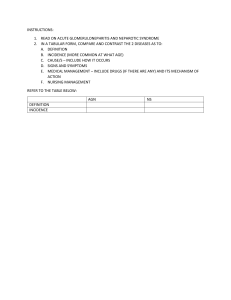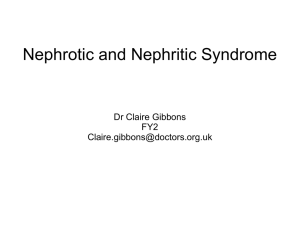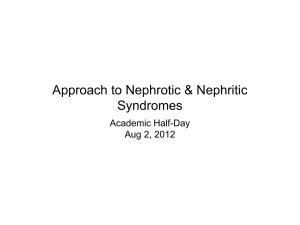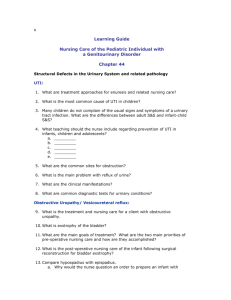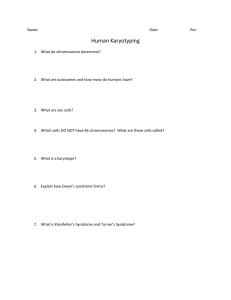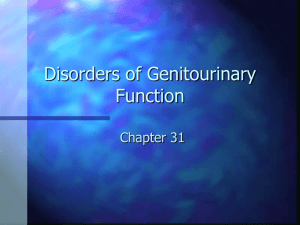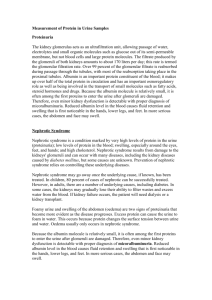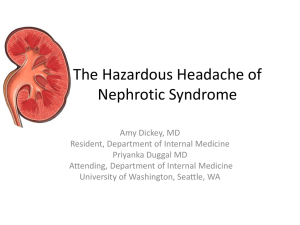Acute Poststreptococcal Glomerulonephritis Case Presentation
advertisement
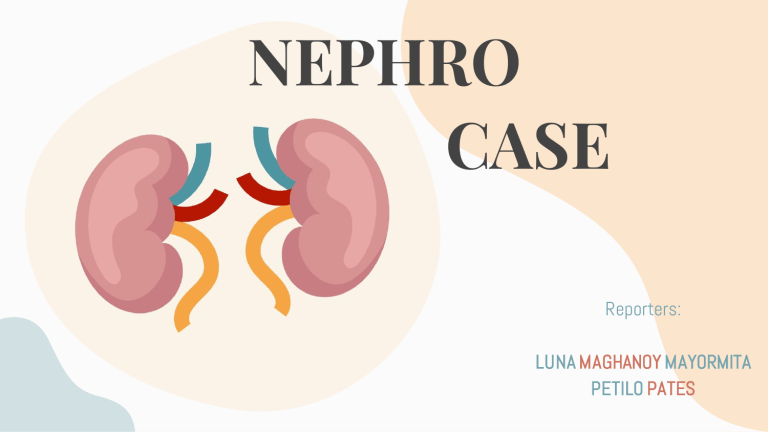
NEPHRO CASE Reporters: LUNA MAGHANOY MAYORMITA PETILO PATES GENERAL DATA CJ 2.5 years old Male Filipino CHIEF COMPLAINT Generalized swelling of the body for 5 days HPI 5 DAYS PTA Swelling of face ▪ Acute in onset ▪ Progressing towards abdomen & bilateral upper and lower limbs ▪ Painless ▪ Pitting Overlying skin: normal No history of itching, rash, sore throat and fast breathing HISTORY OF PRESENT ILLNESS No history of: ▪ Frothy urine ▪ Yellowish discoloration of urine ▪ Frank blood in urine ▪ Crying during micturition No history of: ▪ Cough ▪ Chest Pain ▪ Abdominal pain ▪ Loss of appetite ▪ Vomiting ▪ Jaundice HISTORY OF PRESENT ILLNESS No history of: ▪ Skin infection ▪ Petechiae ▪ Purpura ✓ ✓ ✓ ✓ Went to local hospital Medication given UTZ Referred to VSMMC p PAST MEDICAL HISTORY ● ● ● ● Throat infection 2-3 weeks back No hx of similar illness No TB, asthma, HTN, DM No hx of fever with rash and neck swelling ANTENATAL HISTORY No ANC visits No TT vaccines No h/o fever, rashes, lymphadenopathy, excessive No h/o PV bleeding, spotting vomiting, increased frequency & urgency of micturition, burning micturition No Fe2+ & Ca2+ taken No h/o HA, BOV, epigastric pain PERINATAL HISTORY Term via NSD (Parent not sure of exact date) Baby cried at birth BW: 2.0 kg Breastfeeding at 4 hours of life POSTNATAL HISTORY No excessive bleeding and other complications. FAMILY HISTORY No h/o similar illness in the family No h/o consanguineous marriage No h/o TB, DM, HTN, & kidney diseases DIETARY HISTORY • ½ cup rice with fish, egg, occasional pork and vegetables DEVELOPMENTAL HISTORY IMMUNIZATION HISTORY Complete immunization as per EPI schedule Explore drawers, runs up and down the stairs Vertical and circular strokes Asks for food and toilet, 2-3 word sentence General Survey Bilateral pitting edema of lower extremities grade 2 Facial puffiness No scar marks of infection VITAL SIGNS BP 90/60 mmHg R arm, sitting PR 110 bpm Regular, normal vol. & char. RR 22 cpm T 98 F or 36.6 C PHYSICAL EXAMINATION G.P.E. No pallor, no icterus, no lymphadenopathy, no cyanosis, no dehydration Anthropometry 1 G.I.T. 4 2 Weight: 13.5 kg Abdomen distended, umbilicus central, all quadrant moving symmetrically with respiration, no venous prominence, no scar marks, no hernia Palpation: no local rise in temp, no tenderness, no lump, and organomegaly Percussion: Shifting dullness (+) 5 C.V.S. S1S2 No murmurs Chest 3 Trachea central. bilateral chest pansion, normal vesicular breath sounds, no adventitious sounds WHO Growth Chart Interpretation * shaded boxes= NORMAL PHYSICAL EXAMINATION G.P.E. No pallor, no icterus, no lymphadenopathy, no cyanosis, no dehydration Anthropometry 1 G.I.T. 4 2 Weight: 13.5 kg Abdomen distended, umbilicus central, all quadrant moving symmetrically with respiration, no venous prominence, no scar marks, no hernia Palpation: no local rise in temp, no tenderness, no lump, and organomegaly Percussion: Shifting dullness (+) 5 C.V.S. S1S2 No murmurs Chest 3 Trachea central. bilateral chest pansion, normal vesicular breath sounds, no adventitious sounds LABORATORY BIOCHEMICAL PARAMETERS PARAMETER RESULTS REFERENCE RANGE UREA 14 mg/dl 10-50 CREATININE 0.4 mg/dl 0.5-1.4 SODIUM 127 mmol/L 136-145 POTASSIUM 3 mmol/l 3.5-5.0 TOTAL PROTEIN IN 24 HOURS URINE 375 mg/ g/ day • • URINE CULTURE AND SENSITIVITY STERILE AFTER 24 HOURS HBsAG, HCV AND HIV NEGATIVE URINE RE RESULT Albumin 4+ Sugar Nil MICROSCOPIC TEST WBCS 10-15/ hpf RBCS 20-30/ hpf Epithelial cells 3-5/ hpf Others Not seen PARAMETERS RESULTS Blood group O positive REFERENCE RANGE CBC Hematological Parameters Hemoglobin 12.8 gm/ dl 11-16 gm/ dl PCV 35.9 36-48% TLC 9400 4000- 11000 cell/mm Neutrophil 25 40-75% Lymphocyte 60 20-45% Monocyte 6 2-10% Eosinophil 9 1-6% Platelet 324,00054 150,000400,000 cell/ mm cu ESR 54 SALIENT FEATURES Ancillary Exams History Acute generalized swelling of the body for 5 days • Previous throat infection (2-3 weeks ago) • No ANC visits • BW 2.0 kg Physical Examination • • • • • • • Facial puffiness Bilateral pitting edema of lower extremities (G2) Shifting dullness on abdomen No cyanosis or pallor No tachypnea or dyspnea No murmurs BIOCHEMICAL PARAMETERS • Creatinine 0.4 mg/dl - dec • Na 127 mmol/l - dec • K 3 mmol- dec URINALYSIS • Albumin 4+ • WBC 10-15/HPF - inc • RBC 20-30/HPF - inc HEMATOLOGIC • Neutrophil 25 - dec • Lymphocytes 60 - inc • Eosinophil 9 - inc • ESR 54 (1st hr) - inc DIFFERENTIAL DIAGNOSIS Salient Features 2.5 y.o., Male Acute onset Focal Segmental Glomerulosclerosis Minimal Change Syndrome Acute Poststreptococc al Glomerulonephritis + + + (2-10 yo; M>F) (2-6 yo; M>F) (all ages; M>F) + + + (periorbital) + + (periorbital) + + + + + (severe) + (severe) - - + Generalized swelling • • • Facial puffiness Bilateral pitting edema Shifting dullness and distention of abdomen Previous throat infection +++ DIFFERENTIAL DIAGNOSIS Focal Segmental Glomerulosclerosis Minimal Change Syndrome Acute Poststreptococcal Glomerulonephritis Creatinine 0.4 mg/dl dec Na 127 mmol/l - dec K 3 mmol- dec Normal in early stages + + + + + + + + Albumin 4+ WBC 10-15/HPF - inc RBC 20-30/HPF - inc + - + + + + + (60-80%) + (10-20%) + (gross hematuria) +/+/+/+/- +/+/+/+/- + + + + Salient Features Neutrophil 25 - dec Lymphocytes 60 - inc Eosinophil 9 - inc ESR 54 (1st hr) - inc WORKING DIAGNOSIS: Acute Poststreptococcal Glomerulonephritis CASE DISCUSSION INTRODUCTION ETIOLOGY EPIDEMIOLOGY PATHOLOGY & PATHOGENESIS CLINICAL MANIFESTATIONS DIAGNOSIS TREATMENT COMPLICATION PROGNOSIS PREVENTION ACUTE POSTSTREPTOCOCCAL GLOMERULONEPHRITIS ACUTE GLOMERULONEPHRITIS - inflammation and/or cellular proliferation of the glomeruli not caused by direct infection of the kidneys Nephritic Syndrome - hematuria - proteinuria - volume overload Nephrotic Syndrome - severe proteinuria - hypoalbuminemia - edema ACUTE POSTSTREPTOCOCCAL GLOMERULONEPHRITIS • Primary disorder of the kidneys with extrarenal manifestations being secondary to renal dysfunction • Caused by Group A Streptococcus ETIOLOGY: Group A Beta-Hemolytic Streptococcus • M proteins - determines its virulence • Serum Opacity Factor - determinant of secondary sequelae of GAS infection NEPHRITOGENIC STRAINS: • Pharyngitis: M-12 , 1, 4 and 25 • Skin Infections: M- 49 , 2, 42, 56, 57 and 60 EPIDEMIOLOGY: ● ● ● PSGN the most common glomerulonephritis in children worldwide. - commonly affects 5-12 y.o. Global burden: 450,000 /year - developing countries PNSP Renal Census (1995-2007) - 7973 cases (25%) PATHOPHYSIOLOGY ANATOMY Podocytes KIDNEY GLOMERULUS GLOMERULAR BASEMENT MEMBRANE HISTOLOGY Normal Glomerulus Poststreptococcal Glomerulonephritis NEPHRITIC SYNDROME Characteristics: ✓ Peripheral & Orbital edema ✓ Hematuria (Cola colored urine) ✓ Arterial Hypertension ✓ Oliguria Lab tests: ↑ Creatinine & BUN Urine test: Hematuria, Proteinuria, RBC casts NEPHRITIC SYNDROME Trapped in the Glomerulus TYPE III HYPERSENSITIVITY * Immune Complexes* Antigens Antibodies IgG and IgM Carried through the blood KIDNEY Glomerular Basement Membrane (GBM) GLOMERULAR BASEMENT MEMBRANE Hematuria Activation of: C3 complement Cytokines Oxidants Proteases Proteinuria <3.5g/day Oliguria ↑ Blood Pressure Salt and Water retention INFLAMMATION Damage podocytes Cola colored urine Allow larger molecules to pass: ✓ RBC ✓ Proteins Peripheral edema & Periorbital edema HISTOLOGY NEPHROTIC SYNDROME Characteristics: ✓ Proteinuria >3.5g / day ✓ Dyslipidemia (Hypercholesterolemia) ✓ Hypoalbuminemia ✓ Peripheral Edema Urine test: Frothy urine (Fatty casts) NEPHROTIC SYNDROME ↑ risk for thromboembolism Liver compensates Albumin Produce more CHON Hypercoagulable state (↓ Antithrombin III) ↑ Cholesterol ↓ Albumin (Hypoalbuminemia) ↓ Plasma Oncotic Pressure Proteinuria >3.5g/day H20 & Electrolytes Move into interstitium ↓ Immunoglobulins Lipids Frothy urine (Fatty casts) HYPERCHOLEST -EROLEMIA Increased risk for infection PERIPHERAL EDEMA NEPHROTIC NEPHRITIC ONSET Insidious Abrupt EDEMA ++++ Generalized, periorbital ++ Normal Increased Normal or low Increased CLINICAL MANIFESTATIONS BLOOD PRESSURE JVP NEPHROTIC NEPHRITIC Usually normal Low Normal High ++++ >3-3.5 g/24h ++ <3 g/24h +/- +++ Fatty casts RBC casts; cola/smoky urine Mostly normal Elevated (severe) URINE VOLUME SPEC. GRAVITY PROTEINURIA HEMATURIA URINE CASTS UREA/CREA NEPHROTIC NEPHRITIC Low Normal or slightly reduced Normal May increase POTASSIUM Decreased May increase UREA/CREA Normal (early) High (RF) May increase OTHERS Hyperlipidemia BLOOD SERUM ALBUMIN SODIUM CLINICAL MANIFESTATIONS 1-2 wk Streptococcal pharyngitis ACUTE NEPHRITIC SYNDROME Streptococcal pyoderma 3-6 wk Normal renal fxn Asymptomatic microscopic hematuria Gross hematuria Acute renal failure ACUTE NEPHRITIC SYNDROME Peripheral Edema Oliguria Hypertension Pulmonary Heart failure Respiratory distress Orthopnea Cough Encephalopathy BOV, severe HA Altered mental stat New seizure ATYPICAL CLINICAL MANIFESTATIONS Nephrotic syndrome Subclinical disease Purpuric rash Severe disease but (-) initial UA abnormalities CLINICAL MANIFESTATIONS 6-8 weeks Acute phase resolves 4-6 weeks Urinary protein excretion and hypertension normalize 1-2 years Persistent microscopic hematuria DIAGNOSTIC MODALITIES • History & PE o Recent GAS infection • Urinalysis o RBCs, RBC casts, proteinuria, & PMNs. DIAGNOSTIC MODALITIES • Blood workup o mild normochromic anemia • Antistreptolysin O (ASO) titers o confirms a recent streptococcal infection. DIAGNOSTIC MODALITIES • Serum C3 o ↓ in the acute phase • MRI o Patients with severe neurologic symptoms COMPLICATIONS HYPERTENSION Hypertensive encephalopathy Intracranial bleeding HEART FALURE ELECT. IMBALANCE ↑K, ↑PO4, ↓Ca, Acidosis SEIZURES UREMIA ACUTE RENAL FAILURE Dialysis PREVENTION • Family members of patients with acute GN, should be considered at risk and be cultured for GAS. • Dogs have been reported as carriers. TREATMENT AND MANAGEMENT Antibiotics ❑ ❑ Early systematic antibiotic does not eliminate the risk of PSGN 10-day course of penicillin to limit the spread of nephritogenic organisms Fluids ❑ ❑ Sodium restriction 400mL x BSA + urine output in 24 hours Diuretics ❑ Furosemide 12mg/ kg / dose IV q 6-12hours Antihypertensives ❑ ❑ Calcium channel blockers combined with a diuretic ACE inhibitors Indications for Dialysis ❑ ❑ ❑ Uncontrollable hyperkalemia Fluid overload Increased BUN (>100 mg/dL) PROGNOSIS ❑ Overall prognosis is Good ❑ Volume overload resolves in 10 days ❑ ❑ Serum creatinine levels returns in 3 to 4 weeks 0. 02 to 0.04 deaths/ 100,000 TREATMENT AND MANAGEMENT OF NEPHROTIC SYNDROME The goals of treatment of Nephrotic Syndrome: 1. Relieve the symptoms 2. Prevent complications 3. Delay progressive kidney damage Treatment and Management ● ● Children with mild to moderate edema may be managed as outpatient. Parents may be taught how to use a dipstick and interpret the results. Use of Corticosteroids ● Mainstay therapy for MCNS Treatment of Initial Episode of Nephrotic Syndrome ● Prednisone or Prednisolone single daily dose of 60mg/ m/ day or 2 mg/kg/day, to maximum of 60mg daily for 4-6 wk followed by alternate prednisone (starting at 40mg/m2 qod or 1.5 mg/kg qod) for a period ranging from 8wk to 5mon with tapering of dose. Use of Corticosteroids ● ● 80-90% of children respond to steroid therapy Remission consists of: ○ Protein: creatinine ratio of <0.2 or <1+ protein on dipstick for 3 consecutive days ○ Majority of children respond within the first 5 wk of treatment Managing the Clinical Sequelae of Nephrotic Syndrome 1. Edema ● ● ● Children with severe symptomatic edema should be hospitalized Sodium restriction (<1500mg daily) Loop diuretics (Furosemide) orally or intravenously Managing the Clinical Sequelae of Nephrotic Syndrome ● Patients with severe generalized edema with intravascular depletion (hemoconcentration, hypotension, tachycardia) ○ ○ IV administration of 25% albumin (0.5-1.0g albumin/kg) followed by furosemide (1-2mg/kg/dose IV). Should only be used in collaboration with pediatric nephrologist Managing the Clinical Sequelae of Nephrotic Syndrome 2. Dyslipidemia ● ● ● Low fat diet Dietary fat intake (< 30% cal, saturated fat < 10% cal) Dietary cholesterol ( < 300mg/day ) Managing the Clinical Sequelae of Nephrotic Syndrome 3. Infections ● ● ● ● Counseled regarding the s/sx of Cellulitis, peritonitis and bacteremia Blood culture prior to starting empiric antibiotic therapy Paracentesis (bacterial peritonitis) 3rd generation cephalosporin IV Managing the Clinical Sequelae of Nephrotic Syndrome 4. Thromboembolism ● ● Imaging studies for presence of clot Anticoagulation (heparin, low molecular weight heparin, warfarin) Managing the Clinical Sequelae of Nephrotic Syndrome 5. Obesity and Growth Dietary counseling ● Managing the Clinical Sequelae of Nephrotic Syndrome 6. Relapse of Nephrotic Syndrome ● ● ● Defined as urine protein: creatinine ratio of >2 or >3+ protein on urine dipstick for 3 days. Triggered by UR and GI infections. Treated similar to initial therapy, except daily prednisone is shortened Managing the Clinical Sequelae of Nephrotic Syndrome ● ● Daily high dose prednisone until remission is achieved, then switched to alternate day therapy. Duration of alternate day therapy varies depending on relapses of individual child Managing the Clinical Sequelae of Nephrotic Syndrome 7. Steroid resistance ● ● ● Defined as failure to achieve remission after 8wk of corticosteroid therapy Require further evaluation Caused by FSGS (80%), MCNS or membranoproliferative glomerulonephritis Alternative Therapies to Corticosteroids ● ● Steroid- dependent patients, frequent relapsers and steroid resistant patients (cushingoid appearance, hypertension, cataracts and growth failure). Cyclophosphamide - prolongs the remission and reduces the number of relapses. ○ 2mg/kg single oral dose for 8-12wk Alternative Therapies to Corticosteroids ● Calcineurin inhibitors( cyclosporine or tacrolimus) ○ Recommended initial therapy for children with steroid resistant nephrotic syndrome Mycophenolate- can maintain remission in children with steroid dependent or frequently relapsing nephrotic syndrome. * Most children who respond to cyclosporine, tacrolimus or mycophenolate therapy tend to relapse when medication is discontinued Immunizations in Children with Nephrotic Syndrome ● ● ● ● Full Pneumococcal Vaccination (13-valent conjugant and 23-valent polysaccharide vaccine) Influenza vaccination annually Defer vaccination with live vaccines until prednisone (< 1mg/kg daily or 2mg/kg on alternate days. Varicella-zoster immune globulin for immunocompromised children on immunosuppressive agents PROGNOSIS ● ● ● Children with steroid-responsive nephrotic syndrome have repeated relapses, decreases in frequency as the child grows older. Children who respond rapidly to steroids and those who have no relapses during the first 6 mo after diagnosis are likely to follow and infrequently relapsing course. Children with FSGS, have much poorer prognosis THANK YOU!
